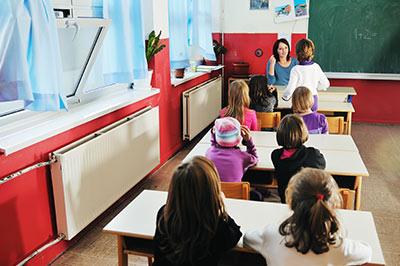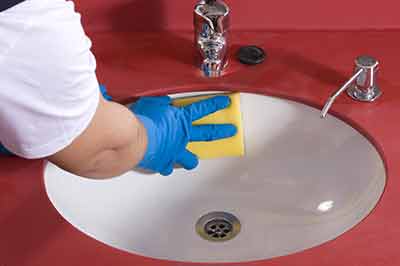By Allen Rathey, Keith Webb, and E. M. Wallace.
What prompts school facilities to get on board with green cleaning programs? The answers vary. For some the decision may be driven by health impact, environmental stewardship, or simply compliance.
Keith Webb, Executive Director of Plant Services, Newport News Public Schools (NNPS), Newport News, Virginia, is pleased that the NNPS cleaning program, under Custodial Supervisor Marcella Bullock, received the Green Cleaning Award for Schools and Universities’ Grand–level recognition in 2013 (American School & University, 2015), but he admits achieving this green milestone took many years and got its start through the “back door”.
“When I first started in 2007, I did nothing but observe,” Webb notes. “I saw we were overstaffed and using ineffective tools—such as cloth-bag upright vacuums, mop buckets with wringers for hard floor care, and lots of cleaning chemical—so our ‘front door’ focus was on right-sizing, efficiency and leaning operations.”
This meant eliminating about 50 FTEs—through attrition rather than layoffs—and diverting a sizable sum of money to purchase leading-edge equipment and supplies, including:
- Backpack-style vacuums—Worn by the operator using a mountaineering-style harness balancing the approximate 10-lb. weight on the hips, and clean about two times the space that an upright-vacuum process can in the same amount of time (ISSA, 2015).
- HEPA-filtered upright vacuums—Newer upright vacuums with proven performance, bodies that do not leak dust and filters that trap fine particles (Carpet and Rug Institute, 2015).
- Engineered-Water Auto Scrubbers—Cordless, powered, and quiet (‘green-rated’ under 70db) (LEED, 2015) floor cleaning machines that, equipped with an electrolysis system, can generate onboard cleaning solution from facility water supplies, scrub, and dry (vacuum/squeegee) floors much faster than mopping and with better results (ISSA, 2015).
- Wall-mounted onsite-generated engineered-water solutions—Produce a cleaning and sanitizing solution onsite using electrolysis of tap water for use in sprayers and other applications (Healthy Schools Campaign, 2015).
Embracing ionized water for cleaning reduced the use of harsher cleaning chemicals by 99%. The resultant cost savings on chemicals helped fund movement toward additional sustainable practices, such as purchasing recycled-content paper and other products. Adding a recycling program to reduce waste has saved the district about $120,000 a year in refuse removal costs.
Training was a key component to NNPS’s evolution to a green program. The value of a green mindset was infused while training custodial staff to use new equipment and products and to improve cleaning methods and standards. 100% of NNPS’ facilities reached the APPA Level 2 cleanliness benchmark. The investment in training and accountability has led to enhanced recognition, performance, and professionalism of custodial staff. (Read more about this in EFC’s 9/17/15 blog.)
Over time, Mr. Webb realized NNPS’s cleaning had “gone green” in a large way, albeit accidentally, by redirecting resources to improving department operations, methods and training that at the same time produced a cleaner, safer, and healthier environment. Green cleaning meshes with the values that underpin the work of NNPS’s Plant Services. First, the program supports the academic agenda by keeping the learning environment clean and safe for both students and staff; it also illustrates the value placed on people by creating a safer, more pleasant work environment for employees and providing them opportunities for professional growth.
Whatever the impetus to ‘go green’, Webb advises peers to start with a single innovation, phase in different green approaches over time, and maintain a long view. “Be patient, it takes time. Consider the life cycle return on investments in staff, equipment, and products and don’t just go with the least expensive upfront option.”
Green cleaning is a WIN-WIN for students, staff, schools, community, and the environment. Perhaps it matters less where schools start that journey, but that they do indeed begin to embrace it.
References
American School & University. (2015). Green Cleaning Award for Schools & Universities. Retrieved from American School & University: http://asumag.com/green-cleaning-award
Carpet and Rug Institute. (2015). Seal of Approval for Vacuums. Retrieved from Carpet and Rug Institute: https://www.carpet-rug.org/CRI-Testing-Programs/CRI-Seal-of-Approval-Program/Vacuums.aspx
Healthy Schools Campaign. (2015). Green Clean Schools Leadership Summit. Retrieved from http://tinyurl.com/od8vd2m
ISSA. (2015). 612 Cleaning Times. Retrieved from http://www.issa.com/education/bookstore/612-cleaning-times-book.html#.Ven3p_Rdfq4
U.S. Green Building Council. (2015). LEED EBOM Version 4. Retrieved from http://www.usgbc.org/credits/eq31
Allen Rathey is President of the Healthy Facilities Institute (HFI) and Executive Director of the 501c3 Process Cleaning for Healthy Schools (PC4HS). Call him at 208-724-1508.
Keith Webb is Executive Director of Plant Services for Newport News Public Schools, a 29,000- student school division in southeastern Virginia. In that capacity he oversees construction, renovation, maintenance, energy management and custodial operations of the division’s 72 buildings. A graduate of Virginia Tech, he joined NNPS as Assistant Maintenance Supervisor, eventually rising to his current position.
In 2011 his department earned the prestigious Facility Masters Award at the Platinum level from National School Plant Managers Association in conjunction with the Virginia School Plant Managers Association. In 2012 Keith earned his Educational Facility Professional designation from APPA. In 2013 NNPS received the Grand Award for the greenest cleaning K-12 school division nationally from American School & University magazine and the Healthy Schools Campaign. Facility Cleaning Decisions magazine named him a Manager of Distinction in 2015.
E.M. Wallace is a Research Associate with the Education Facilities Clearinghouse, a program of the George Washington University and the Graduate School of Education and Human Development. She has a background in community health education and enjoys cross-sector work that promotes child health and wellbeing.






